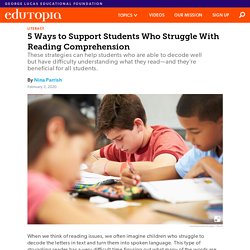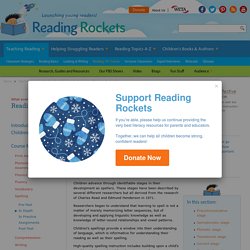

Reciprocal Teaching: Why, How, & Examples. Teaching Text Structures for Non-Fiction Reading. 5 Ways to Support Students Who Struggle With Reading Comprehension. When we think of reading issues, we often imagine children who struggle to decode the letters in text and turn them into spoken language.

This type of struggling reader has a very difficult time figuring out what many of the words are and has poor phonological (speech-sound) skills. However, there are also many students who sound like they’re reading beautifully but have difficulty with understanding vocabulary and figurative language, inferencing, verbal reasoning, grammatical development, and oral expression.
As children get older, if they are decoding text well we assume they are reading well. Once a person learns to decode, reading comprehension becomes more about language comprehension and focus. At this transition, starting around third grade, teachers may begin to notice some students who decode text fluently but are not understanding. Academic Language for Student Success. The Mr. A Show: S1E1 Morphemes and Word Structure. Areas of Literacy Instruction (ALI) - Fluency. What is dyslexia? - Kelli Sandman-Hurley. Station Rotation: Differentiating Instruction to Reach All Students. Critical Literacy: Children as Changemakers in their Worlds. Difference between Phonemic Awareness & Phonics. Spelling: In Depth. Learn about the different stages young children go through in developing their spelling skills and how phonetic or "invented" spelling can play an important role in helping children learn how to write.

Children advance through identifiable stages in their development as spellers. These stages have been described by several different researchers but all derived from the research of Charles Read and Edmund Henderson in 1971. Teaching Literacy with Leveled Readers. Runningrecords. READING AND THE BRAIN: THE 3 CUEING SYSTEMS. Differentiated Instruction for English Language Learners. Each student comes to school, not only with unique academic needs, but also with unique background experiences, culture, language, personality, interests, and attitudes toward learning.

Effective teachers recognize that all of these factors affect how students learn in the classroom, and they adjust, or differentiate, their instruction to meet students' needs. Getting Started Tomlinson and Imbeau (2010) describe differentiation as creating a balance between academic content and students' individual needs. They suggest that this balance is achieved by modifying four specific elements related to curriculum: Content — the information and skills that students need to learnProcess — how students make sense of the content being taughtProduct — how students demonstrate what they have learnedAffect — the feelings and attitudes that affect students' learning. 6 STEPS to making an Infographic. 4 STEPS To Creating an Infographic.